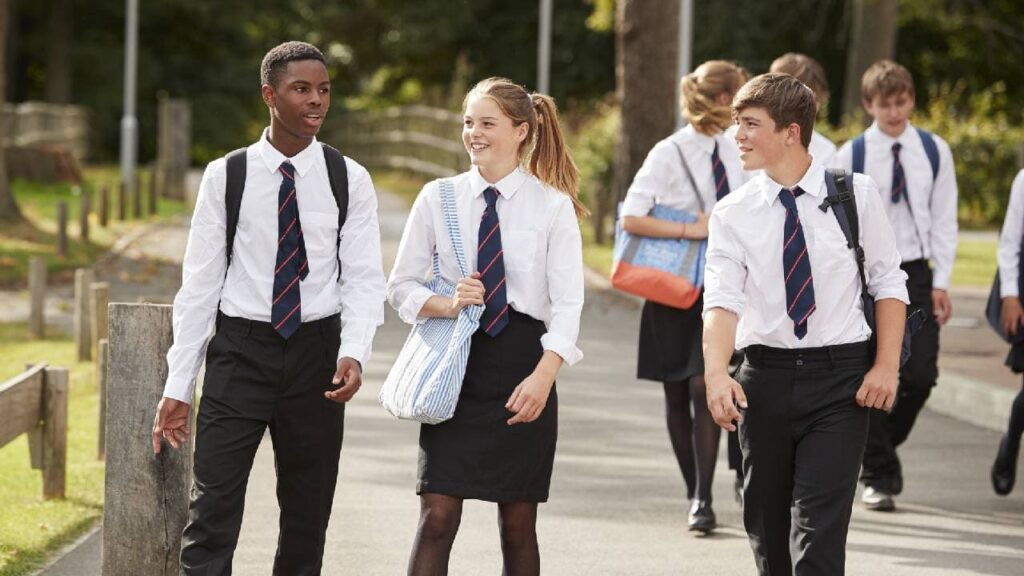It’s something that most of us have memories of; the step up from primary to secondary school. The transition from Year 6 to year 7 brings the unknown, unfamiliar and significantly larger secondary school which can be daunting for pupils. Addressing mental health during this transition is crucial, as the emotional upheaval can significantly impact on children’s well-being.
For some students, the move from primary to secondary school can’t come soon enough. They have outgrown the routines and systems of the school they have been at since they were four years old, and are ready for the next challenge. For others, the summer holidays between finishing Year 6 and starting Year 7 can be a time of worry and anxiety as they prepare to enter a new world.
For parents and carers, this can be an equally worrying time. Striking the right balance between supporting your child to make a positive start independently, whilst wanting to protect and guide them is completely normal. Below is a selection of tips and ideas based on questions commonly heard by primary and secondary school leaders, which we hope will help support a smooth transition.
1. ‘How do I get to my new school?’
For some children, the journey to a secondary school may be some of their first experiences of independent travel and is one of the first hurdles to jump. Many children often travel much further to a secondary school than a primary school, which can involve a bus ride. It is less common for pupils to be dropped off and picked up at the gate by their parents or carers at a secondary school, although for some this works well for an effective transition to secondary school.
Support your child by practising the journey during the end of the summer term at primary school and during the summer holidays. Are they confident with the route? Do they know which entrance to use? What do they do if they miss the bus or get lost? Spending a few hours discussing and physically making the journey to school can reduce anxiety and boost confidence for graduating Year 6 pupils.
2. ‘What do I need to take with me to school?’
Most secondary schools operate on a lesson timetable that involves the pupils moving from room to room, between teachers, for different subjects. This often means that they need to carry multiple books and specialist resources such as their PE kit or Food Technology ingredients. Start by checking the transition literature from the secondary school about basic equipment requirements. If you can’t find it, there will likely be a list on the school website.
This may include stationery, a planner, a water bottle and perhaps a lanyard. Every school is different; be sure to check! Packing a school bag the night before is a really useful habit to form. It will reduce the morning rush and likelihood of forgetting something, which could result in a sanction at school. After the first day at school, the new pupils should have their lesson timetable. Take a photo of this on your phone and pin a copy somewhere easily seen. This should be checked when packing the school bag with any subject specific books packed in a good sized school bag.
3. ‘What is a timetable and how does it work?’
A secondary school timetable can be a really confusing document for somebody who has, for the last 7 years, stayed in one room with one teacher for most of the time! Yet the timetable is one of the most important pieces of information that your son or daughter needs to master, pretty quickly. Divided into days of the week, periods / lessons and possibly times, the timetable denotes which subject and teacher the child has at any given time, and the location in which that lesson will be taught.
Year 6s going into Year 7 need to learn how to read their timetable, and understand what it means in terms of what they need to take to school and where they need to be. Reading through this together, and checking it both every night and morning, will help the familiarisation process. It’s amazing how quickly pupils learn their timetable off by heart and don’t even have to look at it. But for the first few weeks and months, it is invaluable.
4. ‘Who do I go to if I have a problem?’
During the first stages of the new term, it is common for Year 7 pupils to be accompanied by additional adults in lessons and during social times (break and lunch times) so there are plenty of adults to offer guidance. The simple answer to this question is ‘any adult.’ School staff are well used to redirecting lost students or solving problems as they arise. Primary and secondary teachers collaborate to ensure a smooth transition for students, addressing differences in teaching practices and supporting emotional and social adjustments.
Children should never worry about asking for help. It is likely that your child will also be allocated a Form Tutor (a teacher who sees their class daily to conduct administration and pastoral activities – they are often the main point of contact for parents). The Form Tutor is a great adult to talk to about any problems. If they cannot help, they will know who can. There may also be a Head of Year or Wellbeing Leader who new pupils can approach. All of the key adults will be introduced in the first week of term.

5. ‘I’m really worried that I will get lost.’
That’s ok… most Year 7s do at some point! If pupils do find themselves unsure of where to go, it is important that they know to stay calm and ask an adult or another student for help. Showing their timetable to whoever they are asking will help to get them back on track. If your child is particularly anxious about the potential of getting lost, it is perfectly acceptable to contact the secondary school and ask if it would be possible to have a tour of the site with your child after the school day or during the holidays.
If your son or daughter is anxious about not being able to find their way, having the opportunity to explore the site without hundreds of other young people will be a real benefit. Many schools have only a handful of staff in school during the holidays, so it’s best to get this organised as soon as you can.
6. ‘What will they do about my dyslexia / dyspraxia / ADHD / wheelchair use / other special educational need?’
For pupils with additional needs, the transition from primary to secondary school can be even more daunting than for others. The collaboration between primary and secondary schools is crucial in supporting these students. What is really important for your child to understand is that there will be designated adults whose job it is to make sure they are able to access the curriculum and all other parts of school life in the same way as any other child.
The SENCOs (Special Educational Needs Coordinators) from both the primary and secondary school will have met before the summer holidays to hand over key information about each child on the SEND (Special Educational Needs and Disabilities) register and may have even been in touch with you already. If you and your child still have unanswered questions, it’s important to reach out to the SEND team who will be more than happy to talk to you, reassure you and possibly even meet you at the new school to work through an Individual Education Plan (IEP).
7. ‘What about food and the toilet? How does that work?’
For new Year 7s, navigating the canteen and social spaces can be daunting. They’ll transition from a small primary school to a large secondary with older pupils. Canteen procedures are typically explained during Year 6 transition days or on the first day of term. Some schools offer extra time for Year 7s to adjust.
Many use cashless systems; check the school’s website for details. It’s wise to pack snacks, water, and a small amount of cash for the first few days. Discuss the school day schedule with your child, balancing hydration with toilet break rules. Encourage them to speak up if they urgently need the loo during lessons, whilst being mindful of timing.
8. ‘How do I keep in touch with home?’
The answer to this question will depend on the school’s mobile phone policy and how much independence you are trying to encourage. The school’s mobile phone policy and your child’s independence level are key factors. Check the school rules; some ban phones entirely, while others allow usage during breaks.
For urgent matters, your child can request to call you from the school office, student reception or Head of Year. However, this transition offers a chance to discuss independence with your 11-year-old. Encourage them to solve issues on their own. Making time at the end of every school day to ask what happened during the day will give children the opportunity to offload and debrief, allowing opportunity to discuss any issues together and consider how to address any problems together.
9. ‘I don’t want to get in trouble. What are the school rules?’
Primary school rules and secondary school rules are often very different and can take some time for children to get used to. Take time to review any literature sent home during the transition process together, or look on the new school’s website. When exploring the ‘dos and don’ts’ of the new school, it can be useful for children to understand why the school has that particular rule. Why do I only have to walk on the left hand side of the corridor? Why am I not allowed to wear shorts? Why do I need to take my planner every day? The more you can help you child to understand why it is important, the more likely they are to appreciate and adhere to the rules, keeping well away from sanctions and receiving plenty of praise as they go!
A successful transition between primary and secondary schools is crucial for students’ well-being. Involving secondary colleagues early in the transition planning can address emerging issues and ensure a smoother handover for students moving from primary to secondary education.
We hope that the above hints and tips provide an insight into some of the preparation that parents and carers can support as their Year 6 children prepare to move into Year 7.
Whilst it can be a time of great excitement for some, others feel nervous and apprehensive. These feelings are perfectly normal and it is However, as someone who has 14 years’ experience of supporting Year 6s move into Year 7 – take it from me, they will be fine!
Written by Lorna Bradford, Head of Quality Assurance and Impact at Connex Education Partnership.
More from Connex Education
As we strive to meet the diverse needs of neurodivergent learners, quality training is essential for educators. Connex Academy, the sister brand of Connex Education, offers a range of affordable and free courses to help with the pressures of starting the new school year:
- Teacher Self Care
- Are our children suffering from anxiety
- Dealing with anxiety in students
- Mental Health: It is ok, not to be ok
By enrolling on these courses, professionals and parents alike can gain valuable knowledge and strategies for creating a supportive and friendly environment, understanding the unique strengths and challenges students face during exam season, and learning how to effectively support their mental health and well-being appropriately with compassion and understanding.
Why not check out our latest teaching and education roles, we recruit for a variety of role on both permanent and short term contracts, click here to find out more





